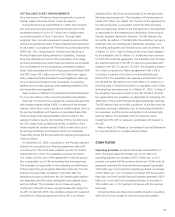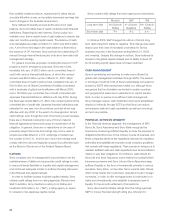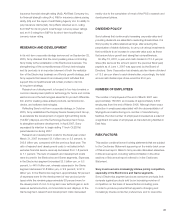Sony 2007 Annual Report Download - page 78
Download and view the complete annual report
Please find page 78 of the 2007 Sony annual report below. You can navigate through the pages in the report by either clicking on the pages listed below, or by using the keyword search tool below to find specific information within the annual report. 75
both in amounts and percentage, and therefore, the decline in
value for those investments was still determined to be temporary
in nature. The percentage of non-investment grade securities
held by Sony Life represents approximately 0.1 percent of Sony
Life’s total investment portfolio, while the percentage of unrealized
losses that relate to those non-investment grade securities was
approximately 1 percent of Sony Life’s total unrealized losses as
of March 31, 2007.
For fixed maturity securities with unrecognized losses held by
Sony Life as of March 31, 2007 (3.1 billion yen), maturity dates
vary as follows:
■ Within 1 year . . . . . . . . . . . . . . . . . . . . . . . . . . . . 0.4%
■ 1 to 5 years . . . . . . . . . . . . . . . . . . . . . . . . . . . . . 96.0%
■ 5 to 10 years . . . . . . . . . . . . . . . . . . . . . . . . . . . . 3.4%
■ Above 10 years . . . . . . . . . . . . . . . . . . . . . . . . . . 0.2%
Sony also maintains long-term investment securities issued
by a number of non-public companies. The aggregate carrying
amount of the investments in non-public companies at March
31, 2007 was 64.9 billion yen. A non-public equity investment is
valued at cost as fair value is not readily determinable. If the
value is estimated to have declined and such decline is judged
to be other-than-temporary, the impairment of the investment is
recognized and the carrying value is reduced to its fair value.
For the fiscal years ended March 31, 2006 and 2007, total
impairment losses were 4.0 billion yen and 7.4 billion yen, of
which 0.2 billion yen and 6.1 billion yen, respectively, were
recorded by Sony Life in Financial Services revenue. Impairment
losses other than at Sony Life in each of the two years were
reflected in non-operating expenses and primarily relate to
certain strategic investments in non-financial services busi-
nesses. These investments primarily relate to the certain
strategic investments in Japan and the U.S. with which Sony
has strategic relationships for the purposes of developing and
marketing new technologies. The impairment losses were
recorded for each of the two fiscal years as these companies
failed to successfully develop and market such technology, the
operating performance of the companies was more unfavorable
than previously expected and the decline in fair value of these
companies was judged as other-than-temporary. None of these
impairment losses was individually material to Sony.
Upon determination that the value of an investment is impaired,
the value of the investment is written down to its fair value. For
publicly traded investments, fair value is determined by the
closing stock price as of the date on which the impairment
determination is made. For non-public investments, fair value
is determined through the use of such methodologies as
discounted cash flows, valuation of recent financings and
comparable valuations of similar companies. The impairment
losses that were recorded in each of the two fiscal years related
to the unique facts and circumstances of each individual
investment and did not significantly impact other investments.
Sony Life and Sony Bank’s investments constitute the majority
of the investments in the Financial Services segment. Sony Life
and Sony Bank account for approximately 85 percent and
13 percent of the investments of the Financial Services segment,
respectively.
Sony Life’s fundamental investment policy is to build an
investment portfolio capable of ensuring stable mid- to long-
term returns through the efficient investment of funds, taking into
account both expected returns and investment risks and
responding flexibly to changes in financial conditions and the
investment environment, while maintaining a sound asset base.
Moreover, as its fundamental stance towards ALM, a method of
managing interest rate fluctuation risk through the comprehen-
sive identification of differences in duration and cash flows
between assets and liabilities, Sony Life takes the distinct
characteristics of liability into account in order to control price
fluctuation risks and establish a portfolio that ensures a certain
level of returns. Sony Life adjusts its investing style depending
on changes in the investment environment. In the first half of the
fiscal year ended March 31, 2007, when interest rates in Japan
were increasing, Sony Life invested mainly in long-term Japanese
government bonds. Sony Life concentrated its investments in
convertible bonds whose prices had declined due to the issuer’s
falling stock price.
Sony Bank operates using a similar basic investment policy
as Sony Life, taking expected returns and investment risks into
account in order to disperse associated risks, and structuring
its asset portfolio to ensure steady returns from investments. In
addition, Sony Bank is careful to match the duration of its asset
portfolio with the duration of liabilities resulting from customer
deposits, in order to ensure that significant discrepancies do not
occur. Government bonds and corporate bonds in yen or other
currencies constitute a majority of Sony Bank’s current portfolio.
To safeguard its assets Sony Bank does not invest in equity
securities but invests in various types of government and
corporate bonds in many countries, companies and industries,
to diversify associated risks. With respect to loans, Sony Bank
mainly offers housing loans to individuals and does not have any
corporate loan exposure.
























